
Google PageSpeed Insights (PSI) is a free tool from Google that analyses and evaluates the performance of your website. Find out here which metrics are available and how you can optimize your website performance. ... Continue reading
| 06 min |


| 20 min |
You are receiving increased inquiries from potential customers from abroad who want to purchase your products? You want to expand and make your website and its content available to a wider market? Then you should prepare it for the international market as well. But this requires some adjustments! Not only should you pay attention to obvious differences such as mentality and culture, but also to technical conditions and requirements. With the help of the right internationalization and domain strategy, this is no problem – we help you find the ideal way.
“Internationalization” – What does it even mean?
What is website internationalization?
What points should you clarify before internationalizing your website?
When is the best time to internationalize?
What are the benefits of internationalizing a website?
What are the requirements for an international website presence?
Requirement 1: Centralized or decentralized – How will your internationalization strategy be aligned?
Requirement 2: Know the market and choose the right languages
Requirement 3: Which domain strategy is right for you?
Requirement 4: Content and proper content maintenance
What are the costs of website internationalization?
Next Steps: Your international website is up and running, but what’s next?
The first entry into foreign target markets: Ads!
Multilingual SEO – How to make your website visible!
Conclusion: Why does it make sense to internationalize companies?
In principle, the term internationalization is largely self-explanatory. It refers to the activities of companies that are entrepreneurial active abroad, beyond their own “home country”. Thereby, the developed markets are to be extended and conquered over national borders in foreign economic areas. In this context, internationalization is the precursor to globalization, which encompasses the development of the world economic area across different continents.
An internationalization strategy is a planned process which enables growth in various foreign markets. However, it is not only the sale of products that is important. The following goals can also be pursued:
In the following, we focus primarily on the last objective: the development of foreign target markets and new target groups.
As a logical conclusion, the internationalization of a website is about a company wanting to expand and accordingly offering suitable websites for the international market. On the one hand, this can mean that it implements a universal, English-language website presence. Alternatively, however, it can also create a website in the respective language of the target country and with target group-specific content. For the latter, there are various domain strategies that you can use according to your goals. You can learn more about this here in this post.
There are several issues that are important in the course of your internationalization strategy. The following checklist will help you piece by piece in preparing for expanding your website.
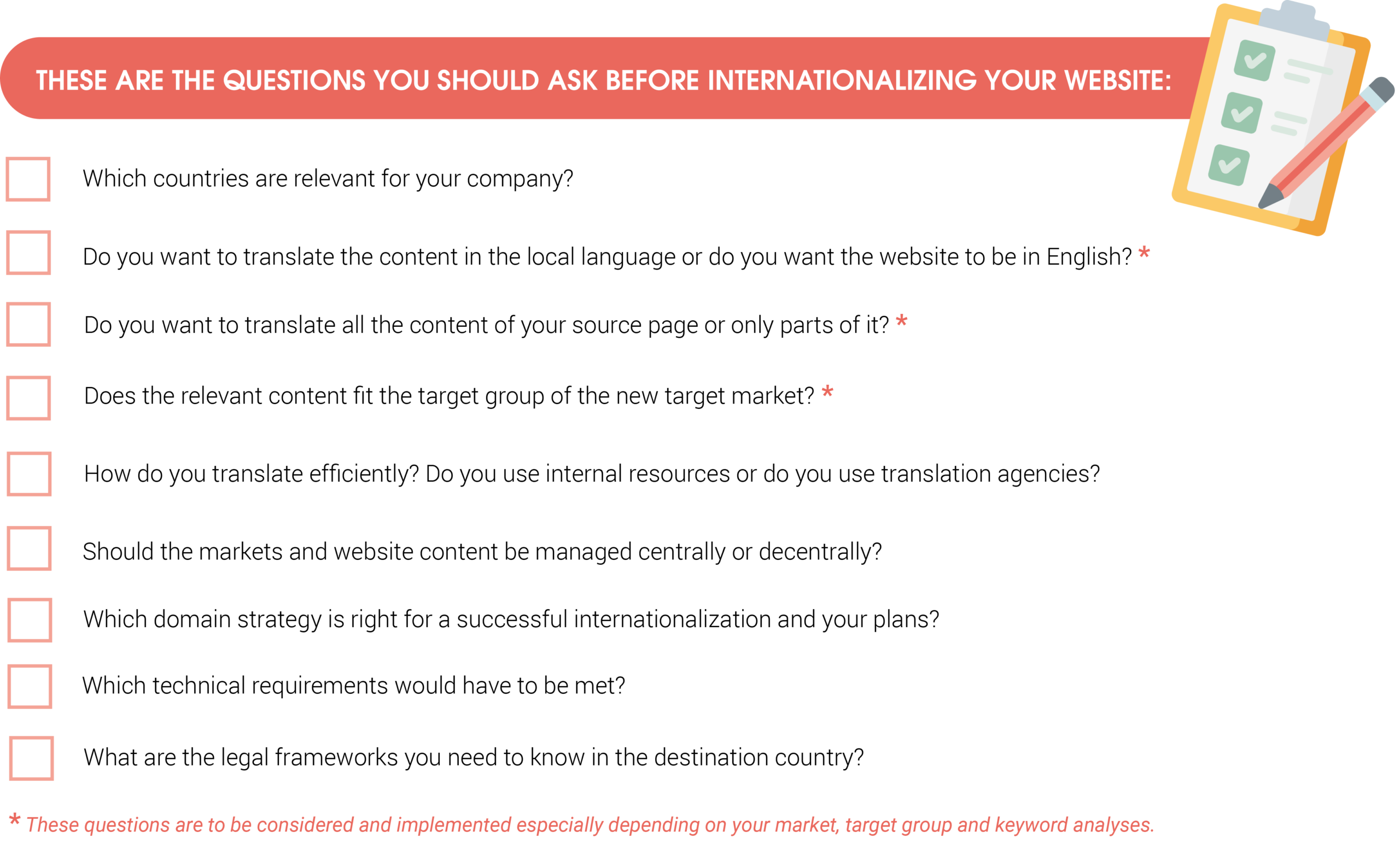
Of course, the list can be supplemented for you individually by some more points. Others may be less relevant. On the whole, however, this checklist lists all the important aspects that you should definitely have on your radar in advance.

To prevent failure in the target market, you should also perform a detailed market analysis. This is the fundamental basis, which gives you about the market potential information. The expansion analysis will also tell you what the competitor situation in the target country looks like and what prices you can expect. In addition, a sound analysis provides you with insight into sales opportunities and the level of advertising costs.
The right time to internationalize, is always when you feel ready. Once that moment has arrived, you should explore your options and address the questions in the previous section. This way you will create a good foundation for the internationalization of your company and your website. Take sufficient time for these preparations. If there are extreme deficits here, this will lead to the failure of your project. Therefore, also here applies: Note the points from the previous section to make sure that you are really prepared!

The biggest advantage is obvious: You reach your target audience abroad with the correct language, the right (country-specific) content and an efficient localization. A country-specific website means not only a more refined address of the target group in the target market, but also a more specific adaptation to search engine requirements in the respective country. Further advantages of an internationally optimized website are:
Your international website has a clear goal: It should address the appropriate target group in the right way in the respective market. This, in turn, should make users aware of your products or services and promote your global growth. To achieve this goal, there are several requirements.
If you want to conquer a foreign market, you can align your campaign strategies in a variety of ways. Use the following chart to see where you can roughly place yourself.
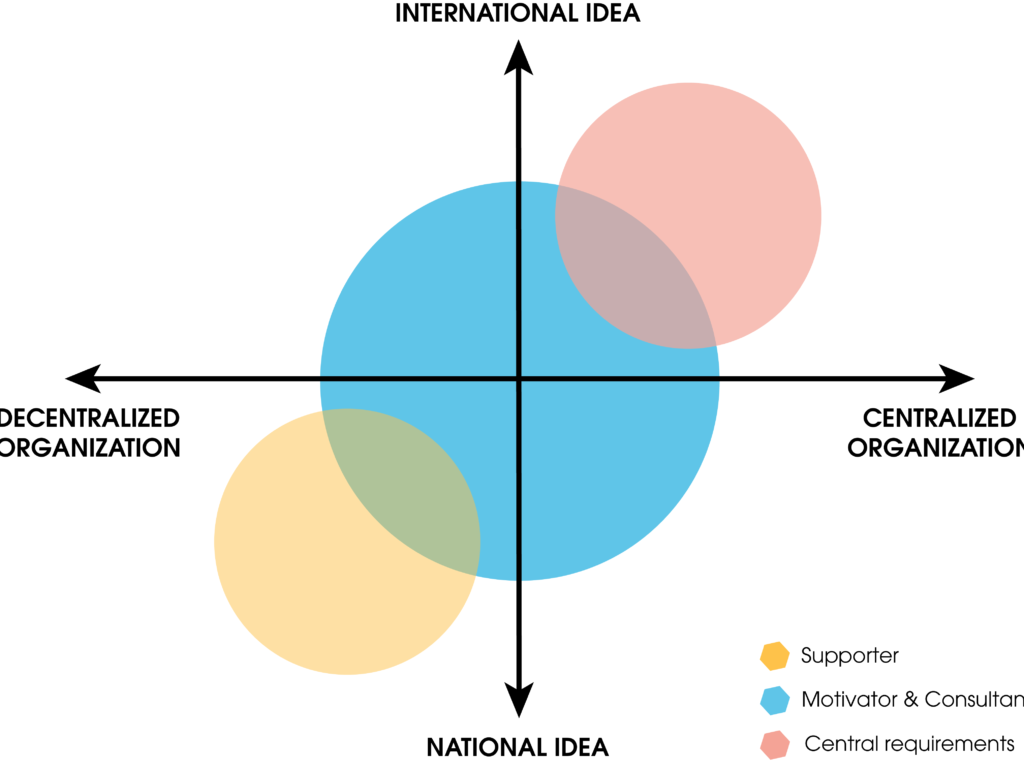
This may look a bit complicated at first. Therefore, here come explanations of the individual postures and their advantages and disadvantages:
| EXPLANATION | PRO | CONTRA | |
|---|---|---|---|
| SUPPORTER | • Your headquarters is only an advisory body • Design, content, communication tools and touchpoints of the campaigns are left to the respective local offices • However, general corporate identity guidelines apply internationally | • Low effort for headquarters • Individual and target group-specific approach to your customers in the target country • Sensible consideration of country-specific circumstances and characteristics | • Little control and fewer steering options at headquarters • Can influence the consistency of cross-country communication • Often associated with higher costs |
| MOTIVATOR & CONSULTANT | • Headquarters is “knowledge provider” and contact person for guidelines, technical basics and procedures • Provides know-how to target markets • Communication materials are created centrally and made available to other offices as templates → Contact persons in local offices are only responsible for content creation and website support | • Better planning of effort at headquarters • Consistent brand communication • Control and steering options through headquarters • Nevertheless target group and market specific content through know-how of the local offices | • Higher initial effort for preparing the templates and setting up the basic measures • Higher coordination effort and more time-consuming communication |
| CENTRAL REQUIREMENTS | • Centralized creation of all campaigns at headquarters | • Maximum control and steering options through headquarters • Unaffected, consistent brand communication • Focus on brand image, corporate promise and brand origin | • Extremely high initial outlay • Manpower must be available at headquarters • No target group-specific content and no influence on the know-how of the target markets |
How exactly you approach your internationalization in the first step is, of course, up to you. Just because you start with central specifications, for example, doesn’t mean that you can’t change your mind sooner or later and rethink your internationalization strategy. Mixed forms of the above-mentioned variants are also possible.
If you want to be successful internationally, it is of course the be-all and end-all to know your target group in the corresponding country well. This includes, among other things, the language spoken in that nation. An international market analysis is therefore essential for your internationalization strategy.
It is important that you choose the right domain strategy to be technically ideally prepared for your expansion. This is also a relevant factor for search engines. There are different domain forms, which we would like to introduce to you here.
These are country-specific domains. That is, you own a separate domain for each country you want to expand into. These can have language pages, which is relevant for example in countries like Switzerland, where different languages are important depending on the region.
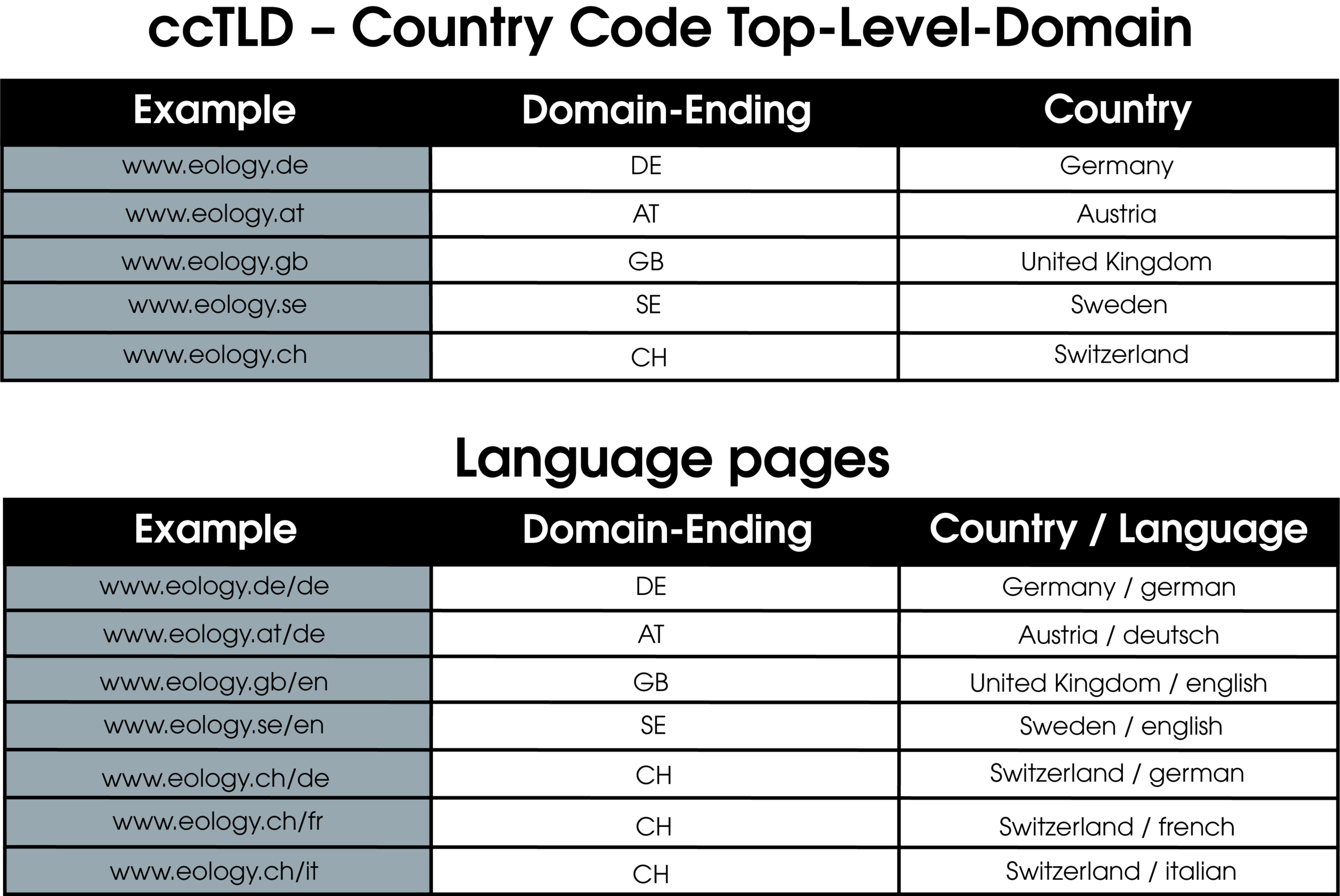
There are no geographical regions behind generic top-level domains. They are rather arranged according to the character or topic of the website. The domain extension .org stands for organizations, .info for informational sites, .gov for government pages and so on. Probably the best known generic domain extension is .com. This stands for “commercial” or “commerce”, which should imply that .com websites have a business aspect.
If you decide for gTLD, you have two possibilities:
Both options can in turn be supplemented with language pages.
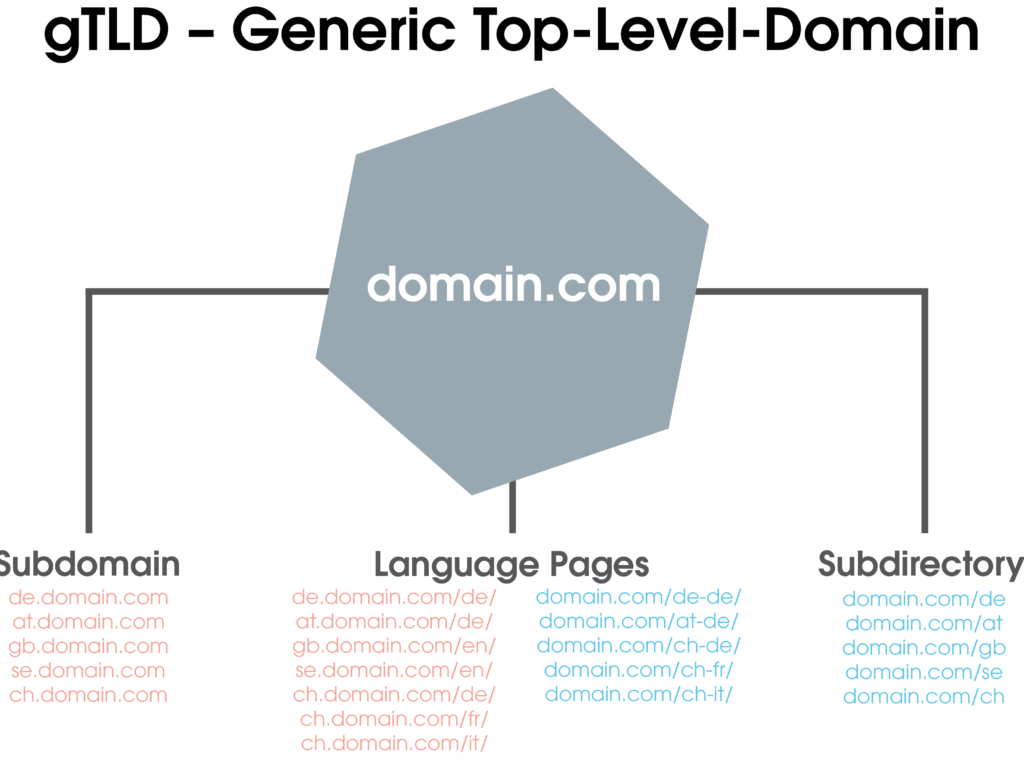

Only if you specify your generic top-level domain by subdomains or directories, they are assignable to a country.
| DOMAIN-FORM | PRO | CONTRA |
|---|---|---|
| ccTLD | • Greater technical flexibility • Simple setup • Strong geo-targeting • Higher trust by users due to domestic domain extension • Websites are easily differentiated and structure is clearer • Overarching penalty risk is minimized | • You start from scratch with each domain and have to build trust and relevance first • Domain management is more complex • Legal requirements: Some countries require a domestic domicile for ccTLDs • Risk of duplicate content without proper customization |
| gTLD with Subdomains | • Google evaluates subdomains like separate domains • Domains can benefit from each other (more trust and higher relevance) • Simple subdivision into country and language versions reduces effort • No overlapping penalty risk | • Less trust with target group abroad • Structure is less clear |
| gTLD with Subdirectory | • Easy technical setup and low maintenance • Profit from existing domains → All links benefit the entire domain (whether external or internal linking). | • Danger from overlapping penalties • Clarity suffers |
Whether centralized or decentralized, the correct content and regular content maintenance is important for the performance of your website. If you play several language versions with content, your effort increases logically. However, there are a few additional things you should keep in mind when it comes to content.
In the first step, it is of course important to clarify whether your content management system (CMS for short) is ready for an international orientation at all. If you want to expand with an online store, this also applies to your shop system.
With standard CMS systems like WordPress you should have no problems for this step. Also, the popular store systems Shopify, Gambio or Magento can be applied straightforwardly for different countries.
There will be one or two pieces of content that you can directly translate into another language. Nevertheless, this is not possible with all of them just like that. When translating, make sure that your content is always adapted to the right target audience. Also some (practical) examples you will not be able to take over one to one. These should also be country specific aligned.

Always adapt your content to your target market and your target group! This may mean that you have to create completely new content.
Just in terms of direct translations, you’re treading the narrow path to duplicate content. To prevent this, you have two options:

Want to learn more about hreflang and geo-targeting? Then check out our hreflang guide!
In general, it can be said that entering a new market often involves a lot of effort and therefore relatively high costs . But depending on how extensive your internationalization project is, these also fluctuate. For laymen who need a lot of external help, a realization is therefore often difficult. Nevertheless, it is worth taking this step. By expanding, you also create new growth potential and the chance for an increase in sales.
Your website is prepared for your target market, now it’s time to get a foothold. You can do this quite easily in the first step by placing ads. Of course, it is important that you choose the correct advertising channels. To decide this, you can look at statistics of search behavior, social media platforms or search engines. After that, other important steps follow:
Would you like to know more about how you can reach your target market with ads or how online marketing can help you open up new sales countries? Then our white paper is just right for you!

If you want to achieve globally good search results and top rankings in the SERPs, there is no way around search engine optimization. Of course, it is important here to know which search engine is relevant in your target country!
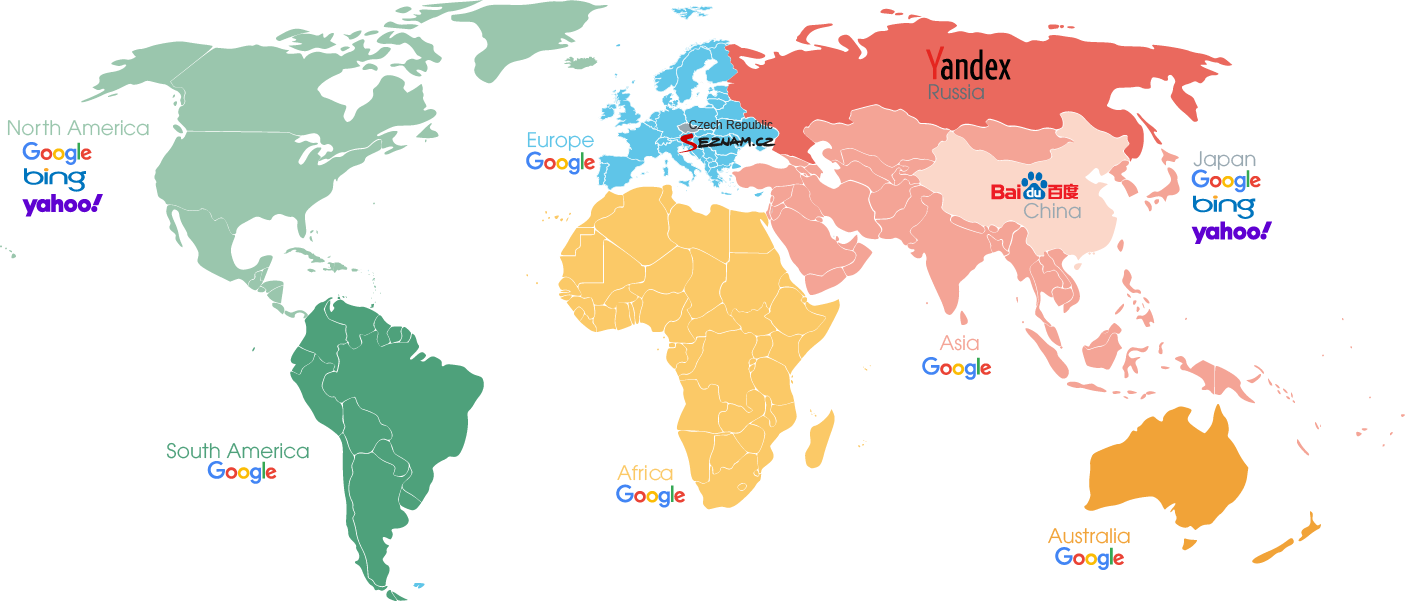
Depending on the country and search engine, there are different ranking factors that you need to consider. Language designations and an appropriate domain strategy also play a role in the performance of your website in the target country. So develop a well thought-out SEO strategy in advance to become internationally visible.

You want to get more detailed information about international SEO? Then go ahead and read our eo:magazine article about it! You can also find more tips on how to ideally tap into the foreign market in the white paper mentioned above. We would also be happy to conduct a non-binding initial consultation about your internationalization plans. For this purpose, you can simply contact us via the contact form.
There are numerous reasons why it makes sense to develop the foreign target market as well. The simplest is probably that you simply reach more potential customers. However, it is important that you make sure that all technical requirements are implemented properly and that you do not put your foot in your mouth in the target market. For this, it is advisable to get native speakers on board who know the customs of their home country. So you are not only linguistically, but also culturally on the safe side.

Olga Fedukov completed her studies in Media Management at the University of Applied Sciences Würzburg. In eology's marketing team, she is responsible for the comprehensive promotion of the agency across various channels. Furthermore, she takes charge of planning and coordinating the content section on the website as well as eology's webinars.

Plans of internationalization? Then you should not miss this content!